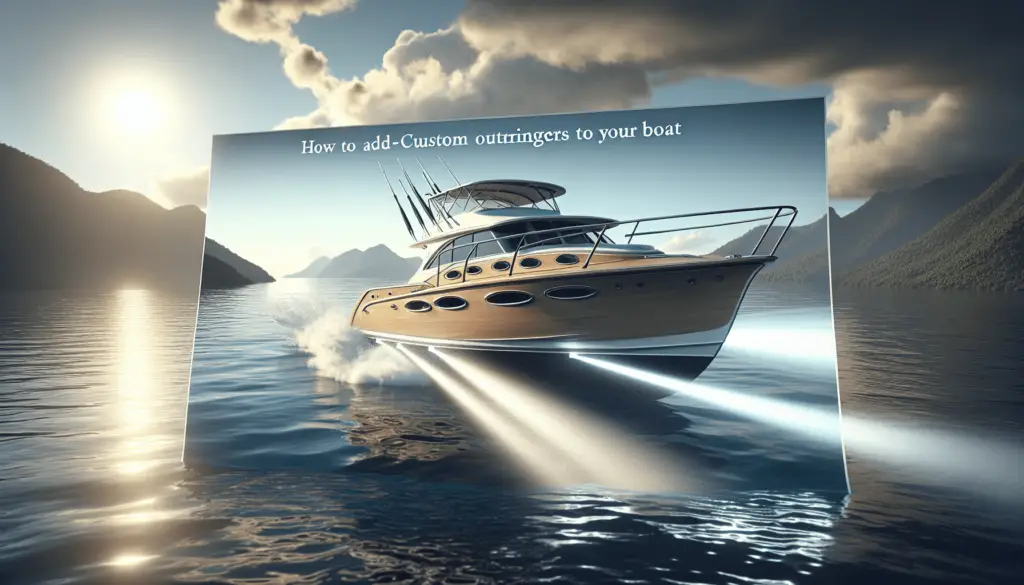Are you looking to enhance your boating experience and take your fishing game to the next level? Look no further! In this article, we will show you the step-by-step process of adding custom outriggers to your boat. Whether you’re an experienced angler or just starting out, outriggers can provide stability, increase your trolling spread, and improve your chances of catching that trophy fish. With our easy-to-follow instructions and a few basic tools, you’ll have your custom outriggers ready in no time, and be ready to cast your line into new waters. So, let’s get started and unlock the full potential of your boat!
1. Assessing Your Boat and Determining Your Needs
When it comes to adding custom outriggers to your boat, the first step is to assess your boat and determine your specific needs. Evaluating the size and type of your boat is crucial in determining the appropriate outriggers to install. Consider the purpose of adding outriggers – whether it is for fishing, stability, or simply enhancing the overall functionality of your boat. This will help guide you in choosing the right type and length of outriggers.
2. Gathering the Necessary Tools and Materials
Before diving into the installation process, it is essential to gather all the necessary tools and materials. Research the specific tools required for installing outriggers on your boat. This may include drills, wrenches, screwdrivers, and other common hand tools. Make a list of materials needed, such as outrigger bases, outrigger arms, rigging materials, and any additional accessories. Additionally, ensure you have proper safety equipment, such as gloves and safety glasses, to protect yourself during the installation process.

3. Choosing the Right Outrigger Type
Choosing the right outrigger type is crucial to ensure optimal performance and meet your specific needs. There are several types of outriggers available, including fixed outriggers, telescopic outriggers, and hydraulic outriggers. Fixed outriggers provide stability and are a popular choice for smaller boats. Telescopic outriggers offer adjustable length, allowing you to customize the outrigger’s reach. Hydraulic outriggers, on the other hand, provide convenience and ease of deployment. Consider the pros and cons of each type before making a decision.
4. Measuring and Mounting the Outrigger Bases
Once you have determined the type of outriggers that best suit your needs, it’s time to measure and mount the outrigger bases. Measure and mark the ideal position on your boat for mounting the outrigger bases. Ensure that the chosen location is sturdy and can withstand the stress of the outriggers. Using a drill, securely mount the outrigger bases to the boat, following the manufacturer’s instructions. Proper alignment during this step is essential to ensure stability and prevent any potential issues in the future.

5. Installing the Outrigger Arms
With the outrigger bases securely mounted, it’s time to install the outrigger arms. Attach the outrigger arms to the bases, following the manufacturer’s instructions carefully. Make sure to properly align and tighten all connections to ensure the outrigger arms are securely in place. Take your time during this step to ensure everything is assembled correctly, as the stability and effectiveness of your outriggers depend on it.
6. Choosing and Installing the Outrigger Rigging
Selecting the appropriate rigging material is crucial to ensure the durability and functionality of your outriggers. There are various rigging materials available, such as stainless steel cable, dacron rope, or synthetic lines. Consider factors such as strength, flexibility, and resistance to corrosion when choosing the right rigging material for your outriggers. Attach the rigging to the outrigger arms, following the manufacturer’s instructions. If necessary, install any pulleys or blocks required to achieve the desired tension and alignment.

7. Testing and Adjusting the Outriggers
Before hitting the water, it’s important to perform a thorough test deployment of your outriggers. Extend and retract the outrigger arms to check for proper functionality and stability. Ensure that the outriggers extend smoothly and retract without any issues. Make any necessary adjustments to the tension, alignment, or rigging to optimize the performance of your outriggers. It’s essential to have confidence in the stability and functionality of your outriggers before taking them out on the water.
8. Adding Additional Outrigger Accessories
To enhance the functionality and convenience of your outriggers, consider adding additional accessories. Outrigger clips or release clips can be useful for securing fishing lines or downriggers. These clips make it easier to deploy and retrieve your fishing lines while providing added stability. Installing outrigger fishing lines or downriggers can also extend your reach and improve your chances of a successful fishing expedition. Additionally, explore optional accessories such as rod holders or storage racks that can provide added convenience and organization on your boat.

9. Maintaining and Cleaning Your Outriggers
To ensure the longevity and optimal performance of your outriggers, regular maintenance is vital. Regularly inspect your outriggers for any signs of wear or damage. Check for loose connections, frayed rigging, or any other issues that may compromise the stability or functionality of your outriggers. Clean and lubricate the moving parts, such as the outrigger arms and pulleys, to prevent corrosion and ensure smooth operation. Replace any worn-out components as needed. When not in use, store your outriggers properly to protect them from damage and extend their lifespan.
10. Consulting Professionals or Seeking Guidance
If you’re unsure about any aspect of adding custom outriggers to your boat, it’s always a good idea to seek guidance from experienced boaters or even consult professionals in the field. They can provide valuable insights and recommendations based on their expertise and experience. Joining online forums or communities dedicated to boating and fishing can also be a great way to gather advice and learn from others’ experiences. If you feel overwhelmed or lack the necessary skills, consider hiring a professional to handle the installation process for you. They have the expertise and knowledge to ensure a proper and safe installation of your outriggers.


